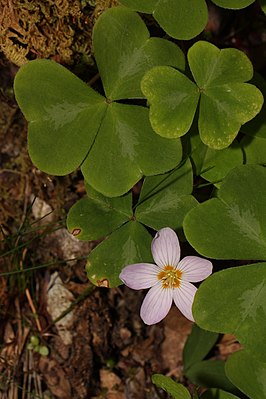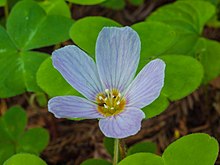Oxalis oregana
| Oxalis oregana | ||||||||||||
|---|---|---|---|---|---|---|---|---|---|---|---|---|

Oxalis oregana |
||||||||||||
| Systematics | ||||||||||||
|
||||||||||||
| Scientific name | ||||||||||||
| Oxalis oregana | ||||||||||||
| Nutt. ex Torr. & A.Gray |
Oxalis oregana is a species of the genus sorrel ( Oxalis ) within the family of Oxalidaceae (Oxalidaceae). It is common in western North America .
Treading
Vegetative characteristics
Oxalis oregana is a perennial herbaceous plant and reaches heights of 5 to 20 centimeters. The rhizome has scales.
The basal leaves are divided into a petiole and a leaf blade. The ascending to upright petiole is 5 to 15 centimeters long. The three leaflets are heart-shaped with a length of 1 to 4.5 centimeters with rosy undersides.
The upright inflorescence stem is 5 to 15 centimeters long and has only one flower. The hermaphroditic flowers have a diameter of 2.4 to 4 centimeters and are radially symmetrical and five-fold with a double flower envelope . The five sepals are 5 to 10 millimeters. The five white to pink petals are 13 to 20 millimeters long and have entire margins. There are two circles with five stamens each; the stamens of one stamen circle are longer than those of the other. There are five styluses.
The hairy, five-chamber capsule fruit is egg-shaped with a length of 7 to 9 millimeters. The seeds are almond-shaped.
Light reaction
Oxalis oregana assimilates at relatively low levels of light (1/200 of full sunlight). In direct sunlight, the partial leaves are folded down and spread out again as soon as shady conditions prevail again. The reaction takes a few minutes but can be seen with the naked eye.
Occurrences and common names
Oxalis oregana occurs in moist Douglas fir and coastal redwood forests of western North America from southwestern British Columbia via Washington and Oregon to California . There the common English names redwood sorrel or Oregon oxalis are used.
use
The leaves of Oxalis oregana were eaten by some tribes of North American Indians , notably the Cowlitz , Quileute, and Quinault . Like spinach , they contain the slightly toxic oxalic acid , which is named after the plant genus.
Individual evidence
- ↑ a b c d Oxalis oregana .
- ↑ a b WTU Herbarium Image Collection .
- ↑ 12.1.1 Light interception and utilization . Archived from the original on March 19, 2016. Info: The archive link was automatically inserted and has not yet been checked. Please check the original and archive link according to the instructions and then remove this notice. Retrieved May 5, 2019.
- ↑ Nyctinasty and Mimosa leaf movement .
- ↑ USDA Plants Profile for Oxalis oregana (redwood-sorrel) .
- ↑ Jim Pojar, Andy MacKinnon: Plants Of The Pacific Northwest Coast: Washington, Oregon, British Columbia & Alaska . Lone Pine Publishing, 2004, ISBN 978-1-55105-530-5 .


